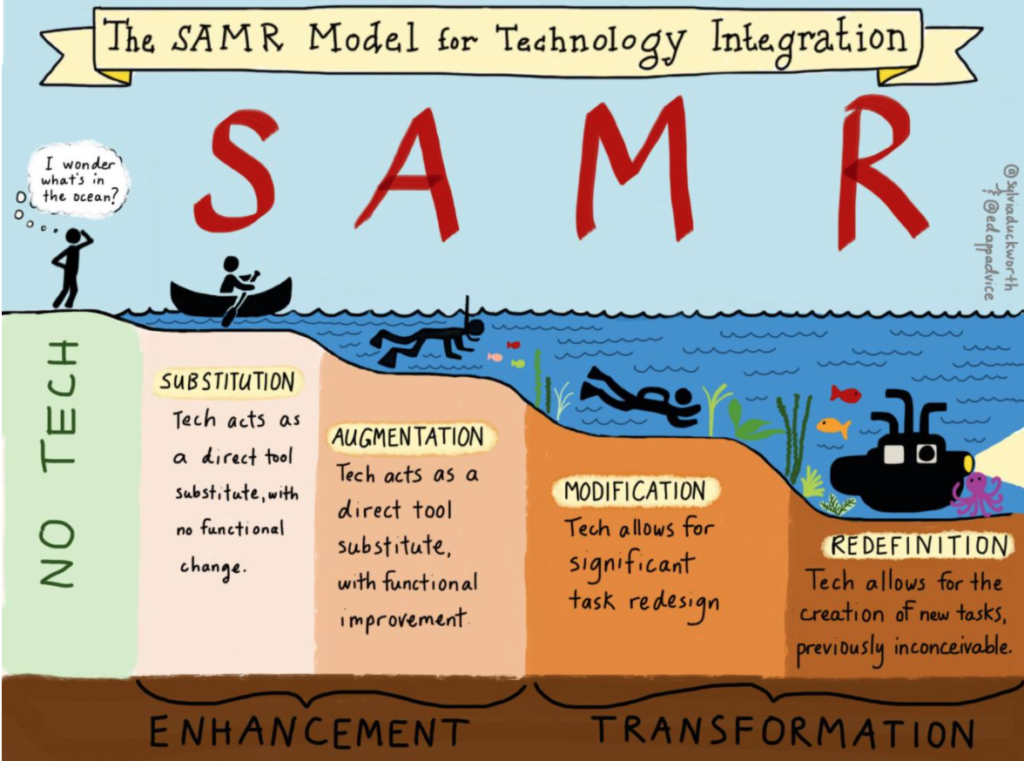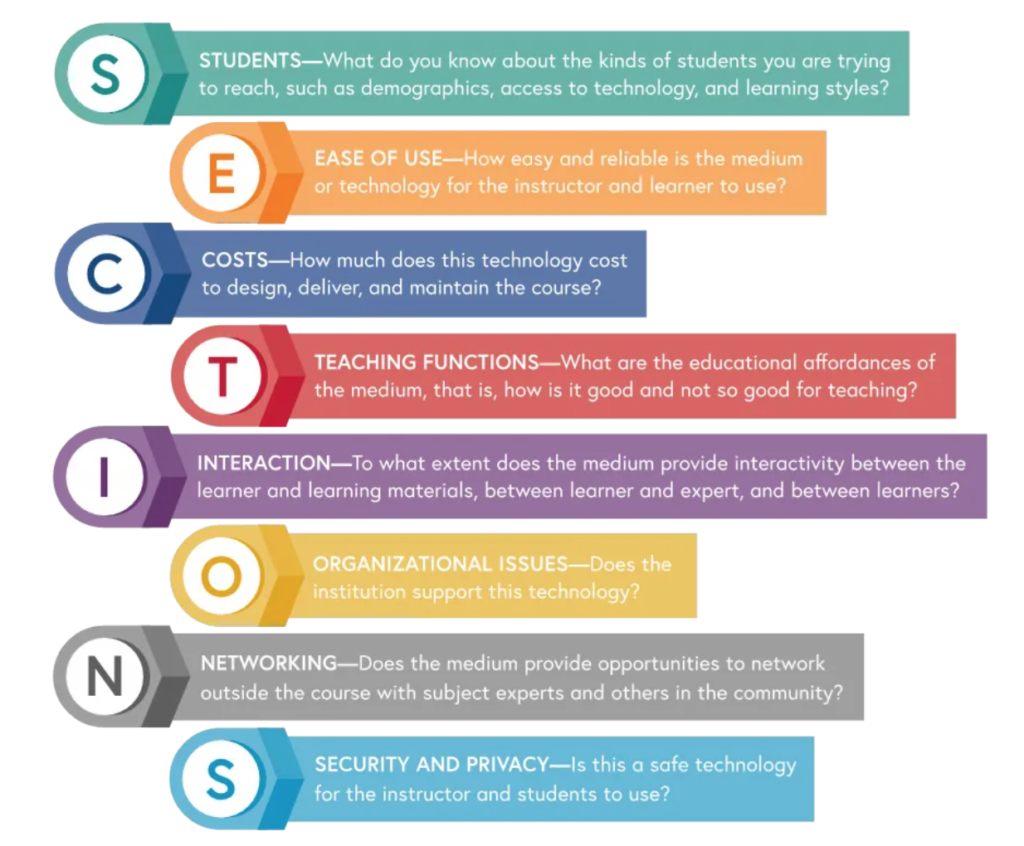This weeks topic really struck home with my teaching pedagogy and they way I organize lessons and assessments for my learners. Not only I have always believed that it is imperative that our learners use technology and media as a way to learn new tech and to absorb information, but I have always believed that it is just as, if not more, important to use them as a way to collaborate with and inform others, as well as to create in a way that is authentic to them.
The SAMR and SECTIONS models enhance my pedagogy by giving me


a quick acronym to abide by so that I can ensure my learners are engaged, enthusiastic and able to transform their learning into new meaningful creations that have the potential to help and inform others. As Dr. Ruben Puentedura puts it, by abiding by the “modification” and the “redefining” sections of the SAMR model, learners are “taking ownership of their education, building excitement and ownership around it and finding joy in it” (Puentedura, 2021). Not only are learners able to find joy and excitement, but so are teachers. I know that the more I work with a certain tech or media and become a “master” of it, the more I want to use it in my lessons or to teach others how to use it for their own purposes. Becomig saavy with it also shows me how I could possibly use it in multiple instances. Puentedura mentions how it is vital for every educator to “continual[ly] reexamine [thier] practice to make the best possible use of technology” (Puentedura, 2021) and I think that using the SAMR model helps us do just that.
This brings me to the SECTIONS model. SECTIONS addresses the “real life” make up of potential learners, teaching spaces and accessibility to wifi/ tools, which can be daunting. If a teacher has difficulty getting their hands on a tool, wifi or support to help them learn about that tool, they will likely give up out of frustration and not implement it. The same goes for the learner who is being asked to use the same tool. Therefore, educators need to pick a tool which is accessible to them and to their learners. They need to lay out thoughtful objectives and steps to get themselves and their learners to the expected destination. As Bates mentions, educators must be, “clear about desired learning outcomes and what kind of skill [they] are going to develop and how can the technology can support the development of those skills” (Bates, 2021). If not, educators and learners will be left using tech and tools as substitution with no greater purpose intended, rather than as a way to redefine and represent understanding in a meaningful and deliberate way. We want out learners to get something out of their use of technology and media rather than have them leaving our lessons like the man in the giphy below.
Finally, I want to address media and editing, as well as SAMR and SECTIONS in assessment. I believe that the more tools a learner has to demonstrate their understanding or knowledge, the better off they are. More tools allow a learner to present information in a way that best suits their abilities and in a way that is motivating because it targets their interests. Assessment then does not feel like work. This course is an example of this in reverse. EDCI 337 is meant to teach us about technologies and tools that we can, and will, use in our future. We need to learn the tools, but we are allowed to create whatever we want using the provided tool. This allowance, gives me the opportunity to create for me and drives my want to create, thus my will to learn. Imagine what learners could create if they had the tools to create in multiple languages so that they could show their learning in a way that is truly authentic, interesting, meaningful and joyful to them.
Citation
Parks and Recreation. “I got nothing out of that experience at all.” Giphy. https://giphy.com/explore/useless
What is the Purpose of School? (2020) Demystifying SAMR with Dr. Ruben Puentedura. https://www.youtube.com/watch?v=L9h9ePoXqS8
Duckworth, Sylvia. (2015, April 2). New #sketchnote The SAMR Model @karlyb @ICTEvangelist @ShakeUpLearning #elemchat @TheTechRabbi #ipaded #ipadedchat http://t.co/1lJAqEE6my [Tweet]. @sylviaduckworth. https://twitter.com/sylviaduckworth/status/583778319235031041
Sarah. (2015, October 4). The SECTIONS Model. https://www.youtube.com/watch?v=cwmo2NLBbkU&t=62s
Bates, T. (2020). Choosing Media. https://www.youtube.com/watch?v=-W79hGvukTs

https://omar-elhalabi.opened.ca/2021/06/10/blog-5-the-effects-of-poorly-made-videos-on-learners/
Hi Omar,
Yet another well laid out and thoughtful post on your part. I too have been a victim of long winded videos that have bored me beyond belief, thus impeding my ability to retain and engage in any learning.
You mention how, “if longer videos were cut into segments, this would be much more favourable for learners to take information in chunks and retain the needed information, then move on to the next.” I completely agree. Isn’t it great that video editing now allows us as educators, or potential educators (as we are all sharers of information), to chunk out the important information and make an already made video better? I know I have some resources that I have created that I will return to, chunk out and improve and I could not be more excited about it. Video editing has come a long way and I am sure has a long way to go. Therefore, we need to stay up to date with what exists so that we can continue creating, chunking, theming and amplifying what we produce.
Thank you again for all your insight.
Hi Jayne,
To hear your perspective about tech in the classroom and its role in engaging and exciting learners is really interesting. I can’t pretend that I ever found school anything except endless tedium, with the exception of time spent in the computer lab, and perhaps that’s telling. I often have the reaction to multimedia as foolish and unnecessary – that it is not ‘serious’ learning. And yet when I see kids having fun / being engaged in tech-enhanced activities with real, important learning outcomes, I see a different and, I am forced to admit, better educational world that they’re growing up in.
To put it concisely, your words along with the content of this course are helping me resolve the differentiated experiences of kids today and my own, and this represents a moment of growth for me, so thank you! I can’t pretend I won’t still have the occasional moment of old-man stodginess, mind you. It’s hard to let go of 🙂